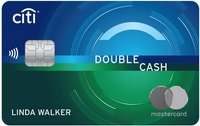Citi Double Cash vs. Citi Diamond Preferred

The Bankrate promise
At Bankrate we strive to help you make smarter financial decisions. While we adhere to strict , this post may contain references to products from our partners. Here's an explanation for . The content on this page is accurate as of the posting date; however, some of the offers mentioned may have expired. Terms apply to the offers listed on this page. Any opinions, analyses, reviews or recommendations expressed in this article are those of the author’s alone, and have not been reviewed, approved or otherwise endorsed by any card issuer.
Key takeaways
- The Citi Double Cash® Card and the Citi® Diamond Preferred® Card both are excellent cards with no annual fees, though each targets a specific type of cardholder and financial goals.
- If you’re looking for simple, flat-rate rewards on all purchases and an intro APR offer on balance transfers, give the Citi Double Cash Card a good look.
- To pay down your debts with longer intro APR offers on both balance transfers and new purchases, the Citi Diamond Preferred could be a better fit — just be sure to pay your balance in full before the intro offer expires to avoid high interest on any remaining balance.
Citi is an advertising partner.
If you’re looking for a no-annual-fee credit card, Citi offers a few attractive products, such as the Citi Double Cash® Card and the Citi® Diamond Preferred® Card. While both Citi credit cards are excellent in their own ways, they’re designed to serve different purposes.
Read on to compare the Citi Double Cash and Citi Diamond Preferred and see which may be worth adding to your wallet.
Main details
| Cards | Citi Double Cash Card | Citi Diamond Preferred Card |
|---|---|---|
| Welcome bonus | Earn $200 cash back after you spend $1,500 on purchases in the first 6 months of account opening. Fulfilled as 20,000 ThankYou® points. | None |
| Rewards rate | 2% cash back on all purchases — 1% cash back when you make purchases and an additional 1% cash back when you pay off purchases | None |
| Intro APR | 0% intro APR on balance transfers for 18 months, then a variable APR of 19.24% to 29.24% | 0% intro APR on purchases for 12 months and on balance transfers for 21 months, then a variable APR of 18.24% to 28.99% |
| Annual fee | $0 | $0 |
Citi Double Cash vs. Citi Diamond Preferred highlights
Let’s take a closer look at the Citi Double Cash and the Citi Diamond Preferred to see how they compare.

Citi Double Cash
-
Many rewards credit cards come with valuable welcome offers that allow you to easily earn a cash bonus or large number of points. That’s not the case with the Citi Diamond Preferred. The Citi Double Cash Card on the other hand has a welcome bonus of $200 cash back after you spend $1,500 on purchases in the first six months of account opening. This bonus offer will be fulfilled as 20,000 ThankYou points, which can be redeemed for $200 cash back.
These cards can offer plenty of value to the right cardholder, but if no sign-up bonus or a higher spend requirement is a deal-breaker for you, you may want to look into a no-annual-fee rewards card like the Capital One Quicksilver Cash Rewards Credit Card, which offers $200 when you spend $500 within the first three months, or the Blue Cash Everyday® Card from American Express, which offers $200 in statement credits after you spend $2,000 within the first six months.

Citi Double Cash
-
If you want a card that earns rewards, there’s no competition between the Citi Diamond Preferred and the Citi Double Cash, because the Citi Diamond Preferred doesn’t earn any rewards.
The Citi Double Cash card, however, is among the best flat-rate cash back cards available. It offers 1 percent back on all purchases you make plus 1 percent back when you pay those purchases off, essentially earning you 2 percent back on everything. Two percent cash back on all purchases is a rare deal in the credit card market.

Citi Diamond Preferred
-
There are two types of 0 percent intro APR offers a credit card can extend: zero interest on balance transfers and zero interest on purchases. The former allows you to transfer a balance from another credit card and not pay any interest for a specified period of time, and the latter comes with no interest on purchases for a specified term.
The Citi Diamond Preferred is the winner here since it comes with both types of 0 percent intro APR offers. With this card, you’ll get a 0 percent intro APR on balance transfers for 21 months and on purchases for 12 months (18.24 percent to 28.99 percent variable APR thereafter). You must complete your balance transfer within four months of account opening, and you’ll have to pay a balance transfer fee of 5 percent (minimum $5) per transfer.
If you’re not planning any big purchases but would like to transfer your credit card debt to avoid interest, the Citi Double Cash is worth considering since it offers a 0 percent intro APR on balance transfers for 18 months 19.24 percent to 29.24 percent variable APR thereafter). You also get an intro balance transfer fee of 3 percent (minimum $5) on balances transferred within the first four months. After the first four months, a balance transfer fee of 5 percent (minimum $5) applies.
Tie
-
Neither card charges an annual fee, so they tie in this category.
Tie
-
Both cards charge a 3 percent foreign transaction fee on purchases made in foreign currency, whether online with a non-U.S. based merchant or while traveling abroad.
Which card earns the most?
Since the Citi Double Cash includes a generous cash back rate, it will undoubtedly provide greater value in the long term, especially when compared to the Citi Diamond Preferred, which offers no rewards.
Citi Double Cash vs. Citi Diamond Preferred spending example
Say you spend an average of $15,000 a year. With the Citi Double Cash, you can earn $300 in cash back (if you pay your balances in full) — earnings you’d miss out on if you went with the Citi Diamond Preferred.
On the other hand, if you plan to carry a balance on your card within the first year and a half, interest payments would eat into your rewards. In this case, the Citi Diamond Preferred could save you more money than the Citi Double Cash since it offers a longer intro period to pay down debt.
Why should you get the Citi Double Cash?
The Citi Double Cash is a great choice if you’re looking for a no-annual-fee card with a simple rewards system. It can also be a good choice if you’re transferring a balance: You’ll get to reduce your credit card debt while saving on interest, and you’ll continue to get decent value out of the card in the long term.
Additional benefits
Besides an excellent rewards rate and balance transfer offer, Citi Double Cash benefits like $0 fraud liability, 24/7 fraud protection, Citi Identity Theft Solutions and Lost Wallet service can be helpful when you need them. You also get access to presale tickets and events with Citi Entertainment.
Redemption options
Redeeming cash back with the Citi Double Cash is just as straightforward as earning it. You can redeem your cash back for a statement credit, check or direct deposit. Or convert your cash back to basic Citi ThankYou points, which you can redeem for gift cards, travel through Citi or shopping on Amazon or through PayPal.
Recommended credit score
To be approved for the Citi Double Cash, you’ll most likely need a good to excellent credit score (670 to 850).
Why should you get the Citi Diamond Preferred?
The Citi Diamond Preferred is a great option if you’re planning a large purchase or balance transfer. Just make sure to pay it off in full while the 0 percent intro APR period lasts — otherwise, you’ll pay a high interest rate (18.24 to 28.99 percent variable APR) on the remaining balance.
Additional benefits
Citi Diamond Preferred benefits include access to Citi Flex Loans, which you can use to borrow money against your card’s credit line at a fixed rate and pay it back over a specified period. You can use this feature with no additional fees or credit inquiries. This can be a convenient option should you need a personal loan in the future. Note, however, that this feature is only available to select cardholders — the issuer must target you for the offer.
Additionally, you’ll get access to Citi Easy Deals, where you can find discounts on various purchases (such as retail and restaurant deals). Finally, like with the Citi Double Cash, you’re able to take advantage of VIP access to events with Citi Entertainment.
Redemption options
The Citi Diamond Preferred doesn’t offer rewards, so there are no redemption options.
Recommended credit score
You’ll most likely need a good to excellent credit score (670 to 850) to qualify for this card.
The bottom line
The Citi Diamond Preferred and Citi Double Cash are both excellent cards with no annual fees, but they target different types of cardholders. If your goal is to earn rewards, the Citi Double Cash is the obvious winner. However, if you’re planning to carry or transfer a balance, the Citi Diamond Preferred takes the lead with its intro APR offers on purchases and balance transfers.
Related Articles



